Well…we’re barely allowed to leave the country the pandemic has presented a blessing in disguise of being able to work remote, no questions asked. From my experiences researching, flying, and driving around Utah, Wyoming, and Colorado, here’s what I learned about
Continue readingBlanca Lake: Hike to a Perfect Alpine Retreat
Seattle is an outdoor lover’s paradise with the Cascades rising an hour to the east and Olympia National Park an hour to the west. No matter which direction you drive, a temperate rainforest awaits with snow-capped mountains visible year-round. When I was in Seattle for a weekend to celebrate my friend’s wedding, I scheduled one day to get out into the mountains — if I only had one day to hike, I was going to make sure it was the best hike I could do. I was sold on Blanca Lake as soon as I saw a picture of the lake.
If I had to describe this hike in one sentence: Words can’t do it justice.

I decided on Blanca Lake and it didn’t disappoint. This challenging hike is a two-hour drive northwest of Seattle in the Henry M. Jackson Wilderness Area in the Cascade Mountains. The trail itself is 7.5 miles round trip, climbing the mountainside in 37 switchbacks before reaching the crest and dropping into the basin where Blanca Lake shines. The trail begins around 2,000 feet and quickly climbs to around 4,700 feet in just under three miles. Once at the crest, the trail descends 500 feet in around a half-mile, ultimately reaching the final destination. Continue reading
Navigating Sydney: Busses, Boats and Trains, Oh My!
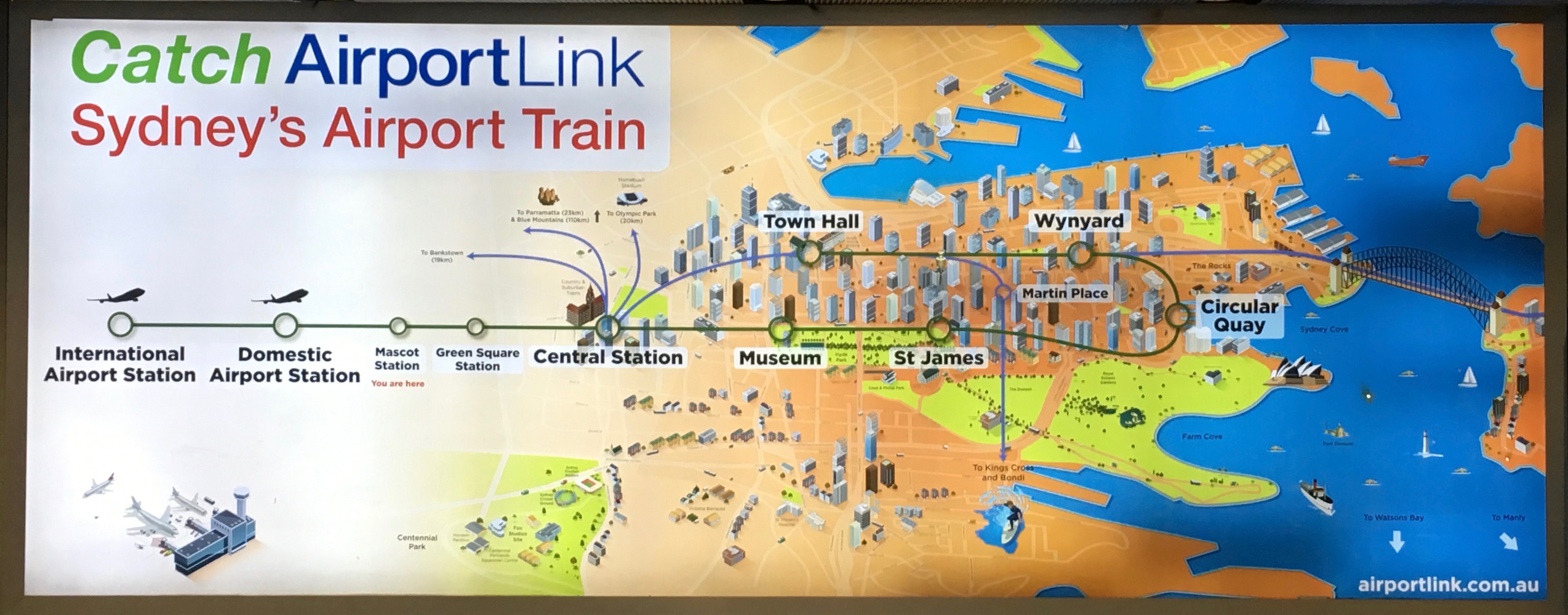
Sydney’s airport to downtown couldn’t be easier
When we made it to Australia a few months back, I knew that the public transit situation was going to be far more interesting than anything I may find in a grocery store with the exception of Kangaroo steaks and the plethora of Tim Tam flavors. For those of you who have yet to discover the wonder of Tim Tams, think of an Oreo. But instead of two cookies with frosting in the middle, there are two chocolate-covered biscuits. Sheer deliciousness. This left navigating Sydney to be one of the sillier things I wanted to do and had to achieve with the week that would inevitably be spent discovering the expansive city.
The present-day transit system was formed in 2013 as Transport for NSW (New South Wales), consolidating the trains, ferries, buses and light rail under a single authority. Sydney Trains is the rail network operator, managing 178 stations across more than 500 miles of track. Sydney Ferries operates eight service lines throughout the Sydney Harbour, all connected through the hub at Circular Quay. Transport for NSW manages six distinct bus networks including 13 rapid routes, hundreds of local routes and a night ride system that operates between midnight at 0430 — replacing rail transit and allowing for rail track maintenance.
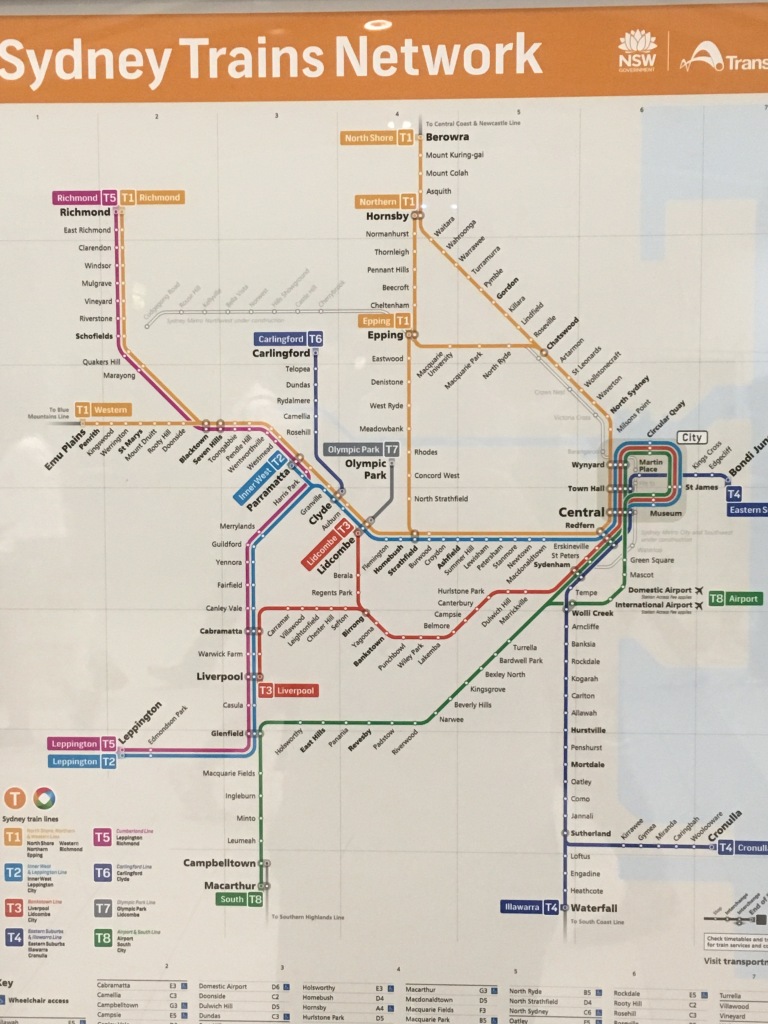
Sydney’s extensive rail network with City Center at its core
Opal Card
The Sydney transit system operates via an Opal card system, which is a tap-on tap-off system. These cards can be purchased with a minimum value of AUD$10 at grocery stores and some gas stations and convenience stores. They can easily be refilled (topped off) at any train station as well as online. Travel in Sydney operates similarly to Washington D.C., paying for the distance you travel instead of per ride. The distance is determined by the number of kilometers and on which form of transit — click here to see the fares. Each time you tap on and tap off, the display at the station barrier tells you the value of your card when you are entering the station or if the ride is counting as a transfer and the cost of your ride when you exit. All this being said, you are capped at spending a maximum of AUD$15/day and AUD$60/week. Disclaimer: A week for the sake of travel in this post runs from Monday to Sunday.
In addition to reusable Opal cards, there are also single-use cards that would not be recommended. A ride across all forms of transit using the single-use card will charge the inflated 30% peak rate.
Pro tips:
- Travel to the airport — both the domestic and international terminals — is more expensive due to an additional AUD$14.30 station fee on top of the local fare. The airport station fee is capped at AUD$29 per week and is seperate from the AUD$15 daily cap. Travel between the two airport stations, Mascot and Green Square charge the respective fees of AUD$5.60 and AUD$8.20.
- Sydney trains charge an inflated 30% rate that during weekday work hours. On-Peak times are between 0700-0900 and 1600-1830. On-Peak times vary when traveling between Intercity stations — more information can be found here.
- Sunday’s are the best day to get the most out of Sydney’s transit system because fares are capped at a total of AUD$2.60 for the entire day. We took advantage of this and went all the way to Manly, which would have definitely reached the maximum fare otherwise.
- After completing eight rides using an Opal card, all remaining rides are discounted at 50% off.
Trains
Landing in Australia after a 16-hour flight did not leave us in a mood to figure out how to get to our friend’s place, especially since they were only a ten-minute Uber from the airport, which is divided into a domestic terminal and an international terminal with subsequent transit stations. We would later learn that getting from the airport to downtown was a breeze. Sydney’s heavy rail serves as both the T and the commuter rail here in Boston, operating both above and below ground depending on the part of the city you’re in. There are eight train lines (conveniently named the T1, T2, etc. with the airport line being the T8) with the four main lines all converging at City Circle — circling the Central Business District and where many of the main attractions are located including the Royal Botanic Gardens, Sydney Opera House, Sydney Harbour and Harbour Bridge and Darling Harbour. The T1, T2, T3 and T8 trains run through each of the stations within City Circle — Central Station, Town Hall, Wynward, Circular Quay, St. James and Museum — as their transition between their inbound and outbound route. It is a 17-minute ride from International Airport to the Sydney Harbour at Circular Quay.
The longest wait we endured for a train was about seven minutes and we never experienced the type of congestion that I have become accustomed to in Boston or New York City. These trains are a continually updated fleet of double-deck electric sets. The most recent set of Watarah trains were rolled out between 2011-2014 and entered 78 sets into service during the three year period. My favorite part about these trains was the adjustable seating — the seat backs could be adjusted to choose which direction you are facing. This way, depending on how busy the trains are, groups up to six can sit together.
Ferries
Circular Quay is the access point for all eight ferry lines as well as the cruise ship terminal. There are six classes of ferries operating a total of 32 vessels. The Manly ferries are both the oldest but also by far the largest with a max capacity of 1,100 passengers. The remaining ships hold a max capacity of between 250 to 400 passengers. Fast ferries are operated by Sydney Adventure Cruises and can be taken from Circular Quay to Manly. Rides take anywhere from the three or four-minute ferry between Milsons Point and Circular Quay to the half hour ride out to Manly. Seeing Sydney from the water was one of the best views we had and something that every visitor should make sure they are able to do.
Popular ferry routes, especially the ones that we did as tourists (Taronga Zoo, Manly and Watsons Bay), fill up quickly so be sure to get to Circular Quay early if you want to get a good seat.
Buses:
Buses are the transportation mode I have the least to say about since we only took the bus four times. One of those times because there was maintenance e on the T8 rail line. We took the bus from Rosebery to Bondi Beach, with a connection at Bondi Junction. You can also get to Bondi Junction via the T4, but have to take the 380 to reach Bondi. The buses feature the same tap-on tap-off system as the trains and ferries.
Opal Fares
| Train | 0–10 km | 10–20 km | 20–35 km | 35–65 km | 65 km+ |
| Adult cards (peak) | $3.46 | $4.30 | $4.94 | $6.61 | $8.50 |
| Adult cards (off-peak) | $2.42 | $3.01 | $3.45 | $4.62 | $5.95 |
| Other cards (peak) | $1.73 | $2.15 | $2.47 | $3.30 | $4.25 |
| Other cards (off-peak) | $1.21 | $1.50 | $1.72 | $2.31 | $2.97 |
| Bus or light rail | 0–3 km | 3–8 km | 8 km+ | ||
| Adult cards | $2.15 | $3.58 | $4.61 | ||
| Other cards | $1.07 | $1.79 | $2.30 | ||
| Ferry | 0–9 km | 9 km+ | |||
| Adult cards | $5.88 | $7.35 | |||
| Other cards | $2.94 | $3.67 |
There’s More to Australia Than Kangaroos?
On slow workday back in October, I looked at my phone and saw an email notification that peaked my interest: “Sale fare: NYC to SYD.” Since one of my usual procrastination tools is to check airfare prices to places I know I won’t be booking tickets to, these emails catch my attention rather quickly. Coincidentally, my boyfriend and I had been joking in the prior weeks about going to Australia to visit one of his friends who was going to be living in Sydney for a few months while his fiancée. This deal was too good to pass up and by the end of the day, we were booked to retreat to the Australian summer for two weeks in February.
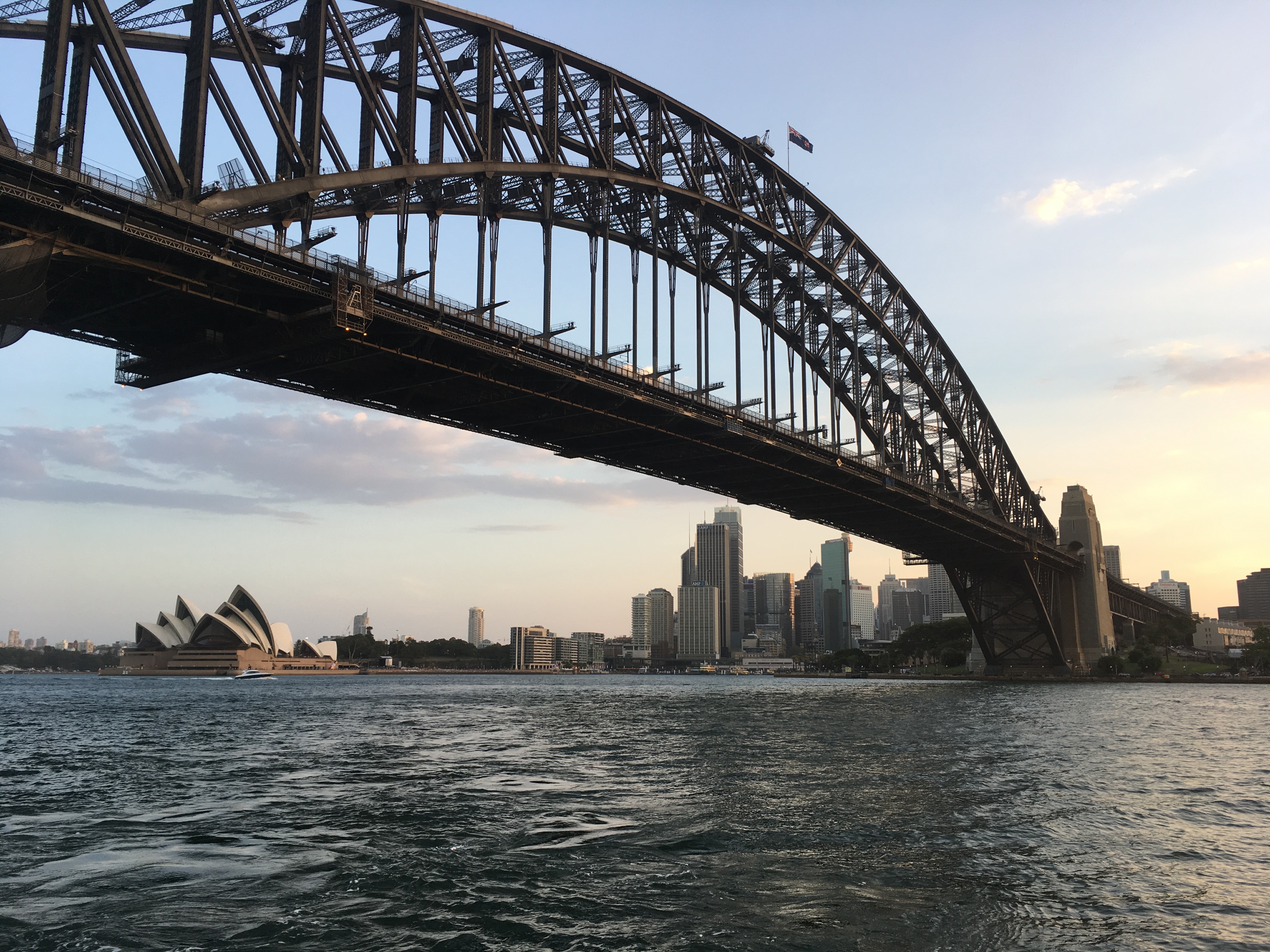
The Harbour Bridge and Opera House from North Sydney
All things considered, I realized that I knew almost nothing about Australia as a country. Most of my knowledge stemmed from basic bits about its geography, that a majority of its wildlife could seemingly kill us and the country’s origin is from penal colonies established by the British Empire after the loss the American Revolution in the late 18th century. Oh, and a bit of WWII and mid-20th-century history that I managed to retain from Peter Carey’s Amnesia — one of the few books I’ve read in the past years that I gave up on halfway through and never returned to.
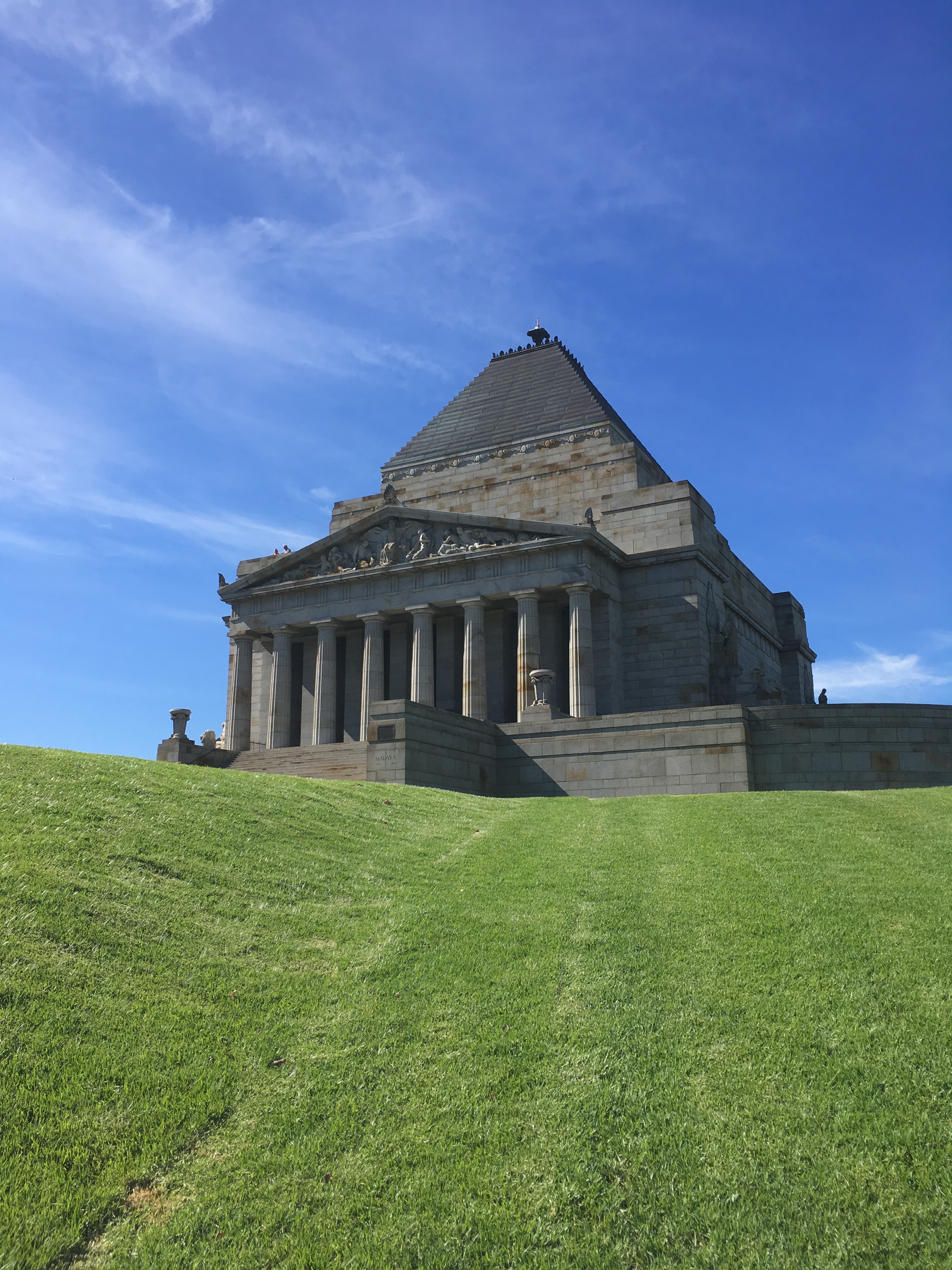
- Melbourne’s Shrine of Remembrance dedicated to Australia’s servicemen and women
Australia harbors a seemingly legendary reputation for a country nearly the size of the contiguous United States and yet a population density of 3.2 people/km2, most closely comparable to the state of Wyoming (2.7 people/km2). Christmas on the beach, waves of the Sydney Opera House, anemones and brilliant colors of the Great Barrier Reef and iconic endemic wildlife have become the things of dreams of many people for whom the continent is an “I’ll get there one-day” type of place. Airfare typically starting at a base fare of $1,200 return along with a minumum of 20 hours flying time probably doesn’t help.
Despite being the third most-sparsely populated country in the world behind Mongolia and Namibia, Australia is highly urbanized. Sydney is Australia’s largest city with a population upwards of 5 million people and encompasses a vast expanse of 12,367 km2 (4,775 sq mi). By comparison, the entire Los Angeles Metropolitan Area is 12,562 km2 (4,850 sq mi). Australia’s second-most-populous city, Melbourne, boasts a population of 4.7 million people and “Global Liveability Report 2017” has been ranked Melbourne the world’s most livable city for the seventh year in a row. Adelaide and Perth, on Australia’s southern and western coasts, also rank six and seven on the 2017 report.
When looking up how to fill the 15 days we’d be spending aboard, I knew one thing we had to do was head north to Cairns to see the Great Barrier Reef. To my surprise — despite being 1,200 miles almost straight north — Cairns, and the entire state of Queensland, is an hour behind Sydney, Canberra and Melbourne. Because things can’t be easy, Australia has three main time zones but they are regulated by the individual states. So one state and one territory — Southern Australia and Northern Territory — are UTC+9:30 as compared to Western Australia’s standard time being UTC+8:00. To make matters more confusing, three states and one territory — Southern Australia, Victoria, New South Wales, Tasmania and Australian Capital Territory (ACT) — experience daylight savings time so there can range from three to five time zones across the country depending on what time of year you visit.
Australia’s government gets even more fun to dig into beyond choosing their respective state’s time zones. A federal parliamentary constitutional monarchy, Queen Elizabeth II still reigns as Queen of Australia, separate from her position as Queen of the United Kingdom. She has representatives at the federal and state level — the Governor-General performs the Queen’s duties in the federal government acting largely on the advice of elected Ministers. The General-Governor — in the name of the Queen — oversees the Parliament, which is divided into the Senate and the House of Representatives. The Executive Government is elected from Ministers already elected to Parliament. The leader of the party with the most support in the House of Representatives is elected Prime Minister, who then selects a cabinet (Senior Ministers) to fill out the remainder of their administration.
Australia is a relatively new country by world standards having declared independence from the United Kingdom in 1901. It is the world’s 13th-largest economy and has the world’s second-highest human development index. Much of Australia’s cultural development, especially in art and literature, has been shaped by the early combination of Western European culture with indigenous influences. Literature slowly grew as it absorbed oral traditions of Aboriginal communities. The foreign bush helped give birth to a uniquely Australian form of impressionism and emerging styles through the 20th century including modern art and the abstract. Famous figures and key events from Australia’s early settlement continue to inspire artists to this day. One particular figure that holds a Robin Hood-esque status is Ned Kelley, a political revolutionary and symbol of the bush’s last stand before industrialization. The State Library of Victoria hosts an extensive exhibit on Ned Kelley’s fascinating life including the reconstructed suit of armor he was wear when the police finally captured him after eluding them for two years. There are also a number of other exhibits on display in the State Library of Victoria that are free to access and celebrate Australia’s history and culture.
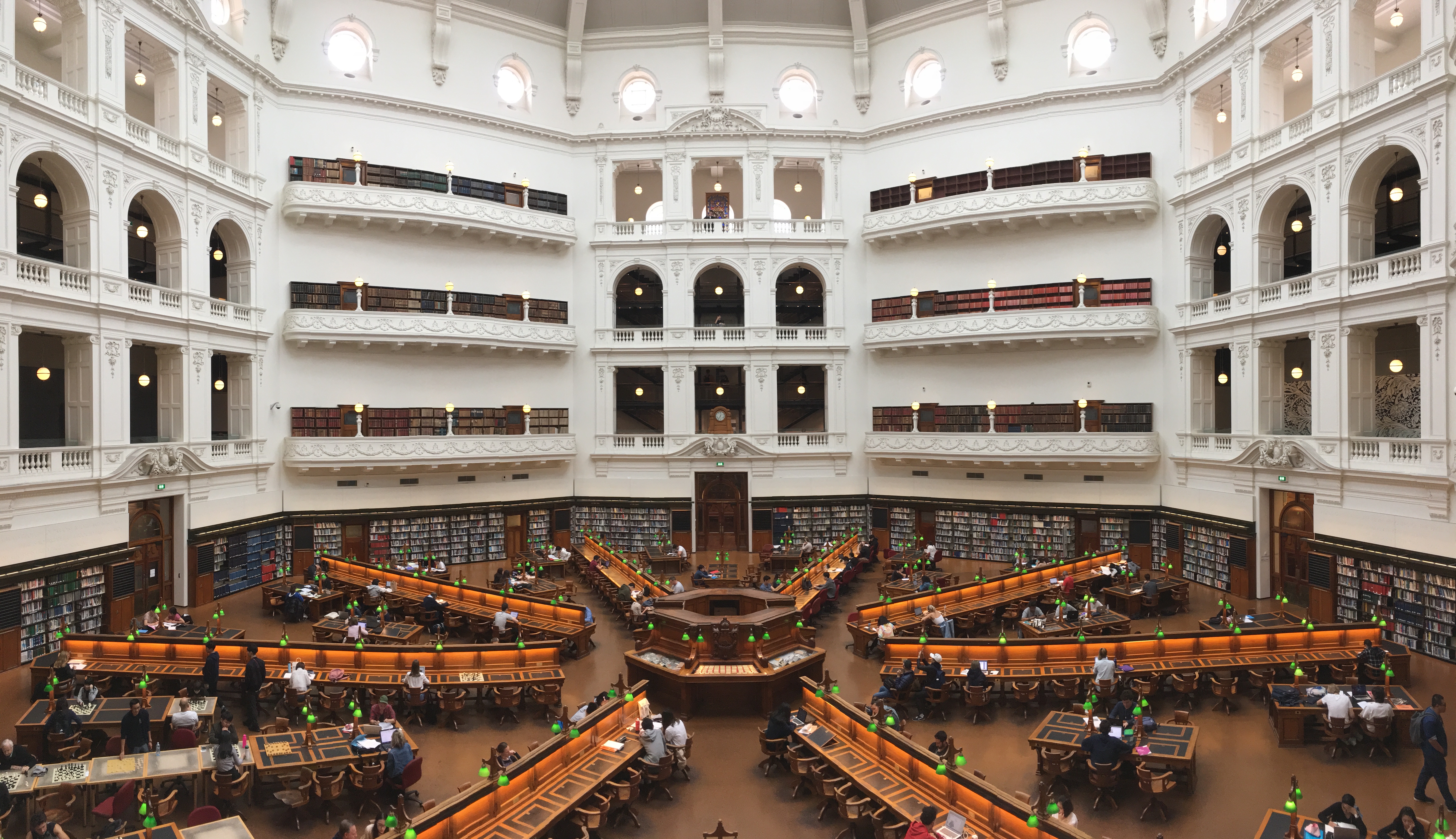
The Redmond Barry Reading Room at the State Library of Victoria
Before the arrival of Europeans, Aborigines inhabited Australia. Living in approximately 250 individual nations with the highest density in modern-day Queensland, scientists believe that their population numbered up to 750,000. When the Europeans began to colonize, Aborigines faced a similar fate to many Native American tribes in the United States; seizure of valuable resources; the introduction of new disease including measles and tuberculosis; and violence at the hands of the new settlers.
A majority of Aborigines did not assimilate into the new society developing in their backyard. Laws rapidly changed as Australia changed hands from a British Colony to an independent Commonwealth. Aborigines were originally allowed to vote as British subjects but local state laws soon superseded and prevented a majority of Aborigines from voting until the Civil Rights Movement in the 1960s. Australia’s current government is trying to reconcile the past with Aboriginal communities and tackle pressing issues including underemployment, drug abuse and obesity to mixed success.
A Point Mugu Reunion
The time had come to finally depart San Diego and make our way north to Los Angeles. Outside of the zoo, this may have been the portion that I was most looking forward to for a few reason — we stopped at La Jolla to explore the tide pools and see the sea lions, finally being rid of the pull-out couch that I had been calling my bed the past few nights, and getting together with the family up in Thousand Oaks. A girl in my Lyft the night before had gotten upset with me for referring to Thousand Oaks as Los Angeles. We expected the drive to only take about three hours with some time to stop at Venice Beach, but forgetting that this was California and there is traffic all day every day, that clearly that didn’t happen.
La Jolla proved to be worth its reputation, as we spent an hour and a half exploring the tide pools and watching the sea lions bask in the sun. Somehow, we managed to find a parking spot fairly easily on Coast Blvd S in between La Jolla Beach and Seal Rock. La Jolla was a playground for exploring rocks that are too slippery to feel safe on and watching waves crash along the beach. After heading to the tide pools, we meandered up to Children’s Pool to see the sea lions. There they were, lounging on the rocks and on the beach, coming in and out of their feeding frenzy. Continue reading
A Family California Adventure
A family function made a perfect excuse to journey to sunny southern California and escape the miserable cold that has plagued Boston for the past two weeks. Previously, my only time in California was in early elementary school, so I remember little beyond devouring bubble gum ice cream in San Francisco. My parents nor I had much of a desire to spend three days in Los Angeles — where my cousins Bat Mitzvah was — so we decided to spend our days a few hours south exploring San Diego.
Like any winter holiday travel, the adventure began with a miserable day of busy airports and near layover misses. Both the Boston and Chicago airports were jam-packed with day-after-Christmas blues and with a 40-minute layover, I was cutting it too close for comfort. Thankfully, my second flight was delayed 20 minutes longer than then my first flight so I was only an hour late to San Diego. My parents arrived a few hours earlier so they had enough time to pick up the rental car, grab some groceries for the Airbnb and even grab a pint at a small bar a few blocks away.
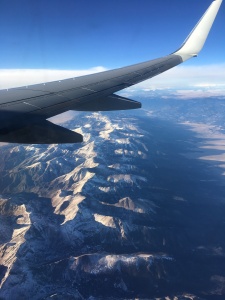
Flying over the mountains
A Little Daydream
On a perfect August night, I found myself in what could be considered my safest space — sitting on my apartment’s roof watching light fade as the sun set. As Boston’s skyline reflected the red and orange streaks behind me, I couldn’t help but think about a conversation I had with my roommate shortly after I got home discussing the day’s news. That it doesn’t seem like real life anymore. It seems like nowadays, everyone is in need of a distraction from reality. Not too long ago, my boss asked me to work on something for her just for fun and practice — she wanted me to write something about the most beautiful place I had ever been. The timing couldn’t have been more perfect.

A beautiful Boston Sunset
New City, New Life
With the passing of July 4th this summer, I have officially been in Boston for two-and-a-half years and the time has flown by. While it hasn’t always been easy, I have no regrets and cannot see myself living anywhere else. Making friends here proved to be a struggle at first, but then I found right where I belong.
I moved here for work — I didn’t know a soul in the city since my sister had moved to Washington D.C. six months prior and my only friend who stayed put after university decided to teach English in American Samoa. Casual, I know. Boston is a young and educated city. How could it not be with such a high concentration of colleges and universities in a relatively small area? Driving down Massachusetts Avenue in Cambridge or walking through The Fenway, it feels like there is always another small university to discover. This however, I feel is Boston’s downfall.
The Marquesas? Where? Oh, French Polynesia…
When life gives you lemons, you make lemonade. One of the perks of working for a company that promotes travel is every once in a while, you get lucky. Back in January — I’m super behind on these — I managed to make my own lemonade and brought my mom along to make it a bit sweeter. With a phone call on a cold Monday morning, I asked my mom if she wanted to go on a two-week-long cruise to French Polynesia. Miraculously, she called me back an hour later saying yes and come Wednesday morning, we were on the plane to meet up in Los Angeles and continue on our way to Tahiti.
When our plane touched down at Fa’a’a International Airport in Tahiti at 3 a.m. with leis around our necks, we met up with the group of adventurous individuals. We would be together for a 13-day cruise with three pre-nights in Tahiti through Road Scholar aboard the Aranui 5. Including my mom and I, there were ten other travelers along with our Group Leader. Following a 20 minute drive, we arrived at Le Meridian on Tahiti’s west coast to check into our rooms and finally collapse into a soft bed after a full day of travel. If someone had asked me three days prior if I ever thought I would go to any island in the French Polynesia, my answer would have been somewhere along the lines of, “maybe on my honeymoon or to celebrate a large event.”
Canyons, Black Sand Beaches, and Glaciers Oh My!
The last day and a half in Iceland. Oh, how time flies when you are having fun, have no plan of what or where you’re going, and the only limitation is getting to the final destination on time.For the last full day in Iceland, we didn’t have much of a plan other than being within driving distance of our 8:00 a.m. entry time to the Blue Lagoon the next morning. The one area we knew we wanted to see was Fjaðrárgljúfur, an immense canyon I’m sure you’ve seen pictures of if you follow travel photographers on Instagram or Flickr.Getting to was arguably the hardest drive I had to do on this trip since it is off a narrow road with lots of ups and downs. Even after three full days of driving, I was going gray in fear of stalling out on the road while someone was driving behind me and getting into an accident — that’s one thing I hope to never accomplish. Getting into an accident in a foreign country. Miraculously, and I have no idea how, but we made it to and from the canyon without a hitch and I managed to stop and start on the hill without stalling — something I’m sure was completely luck.
Preliminary research told us that it’s possible to walk through Fjaðrárgljúfur as opposed to along the east rim, but this didn’t seem to be possible since the water flowing through was impressively high due to the past few days of nearly consistent rain. Braving the seemingly lake-wide puddles that encompassed the dirt paths, we managed to hit just about every viewpoint that was possible without falling to our doom within the canyon. One perk of having continuous rain was all the small waterfalls pouring into the canyon that wouldn’t have been there otherwise. While it was impossible to get into the canyon, the poor nature of the paths and the weather deterred others from walking all the way to the end of the canyon granting us free opportunities to explore and take pictures as we pleased.









